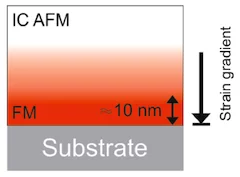Interfaces of transition metal oxides are a fertile ground for new physics, often showing novel electronic and magnetic properties that do not exist in the bulk form of the material. A relatively little-explored direction in this field concerns the interfacial properties of multifunctional materials such as the magnetoelectric multiferroics. A prototypical family of such materials are the orthorhombic rare-earth manganites (REMnO3, RE=Tb, Lu, Y) in which a symmetry-breaking magnetic transition causes the direct coupling of antiferromagnetic (AFM) and ferroelectric properties. Here, we report a study of single-phase LuMnO3 thin films grown on YAlO3 substrates. Remarkably, our experiments show ferromagnetic and antiferromagnetic orders to coexist in the LuMnO3 thin film. The large moment ferromagnetism (≈1μB), which is absent in bulk samples, displays a magnetic moment distribution that is peaked at the substrate-film interface. This observation indicates strongly that the ferromagnetism arises as a consequence of the interfacial strain induced by the mismatch between the film and substrate crystal lattices. We further show that the strain-induced ferromagnetism and the symmetry-breaking antiferromagnetic order are coupled via an exchange field, which demonstrates strained REMnO3 thin films as promising candidate systems for new multifunctional devices.


